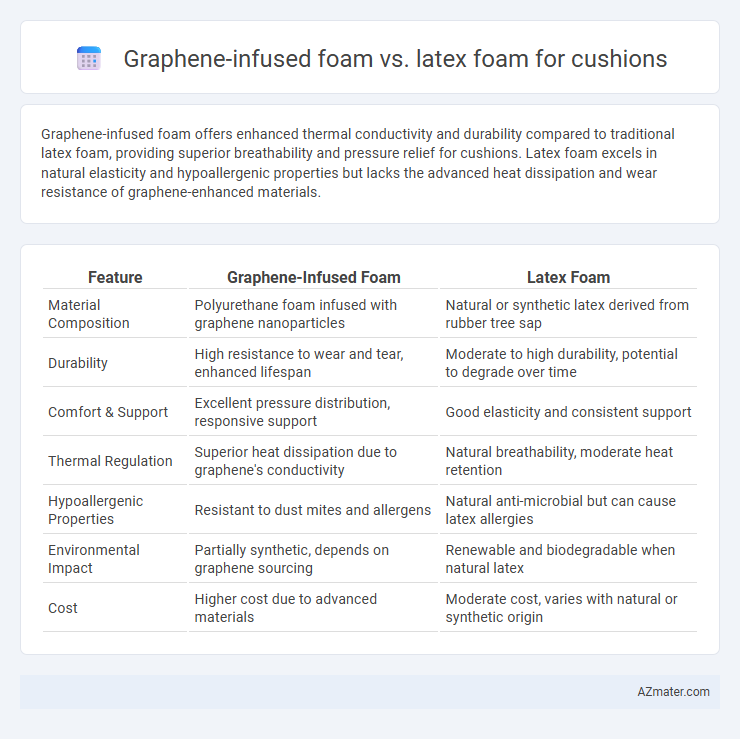Graphene-infused foam offers enhanced thermal conductivity and durability compared to traditional latex foam, providing superior breathability and pressure relief for cushions. Latex foam excels in natural elasticity and hypoallergenic properties but lacks the advanced heat dissipation and wear resistance of graphene-enhanced materials.
Table of Comparison
| Feature | Graphene-Infused Foam | Latex Foam |
|---|---|---|
| Material Composition | Polyurethane foam infused with graphene nanoparticles | Natural or synthetic latex derived from rubber tree sap |
| Durability | High resistance to wear and tear, enhanced lifespan | Moderate to high durability, potential to degrade over time |
| Comfort & Support | Excellent pressure distribution, responsive support | Good elasticity and consistent support |
| Thermal Regulation | Superior heat dissipation due to graphene's conductivity | Natural breathability, moderate heat retention |
| Hypoallergenic Properties | Resistant to dust mites and allergens | Natural anti-microbial but can cause latex allergies |
| Environmental Impact | Partially synthetic, depends on graphene sourcing | Renewable and biodegradable when natural latex |
| Cost | Higher cost due to advanced materials | Moderate cost, varies with natural or synthetic origin |
Introduction to Advanced Cushion Materials
Graphene-infused foam incorporates graphene's exceptional thermal conductivity and strength into traditional foam, enhancing durability, heat dissipation, and pressure relief for cushions. Latex foam, derived from natural or synthetic rubber, offers excellent elasticity, breathability, and hypoallergenic properties, ensuring consistent support and comfort. Comparing these advanced materials highlights the evolution in cushion technology focused on performance, longevity, and user comfort.
What is Graphene-Infused Foam?
Graphene-infused foam incorporates graphene, a single layer of carbon atoms arranged in a two-dimensional lattice, enhancing durability, heat dissipation, and antibacterial properties compared to traditional foam. This advanced material provides superior support and breathability in cushions, making it an innovative alternative to latex foam known for its natural resilience and hypoallergenic qualities. Graphene's exceptional thermal conductivity helps regulate temperature, ensuring a cooler and more comfortable seating experience.
Understanding Latex Foam: Natural vs Synthetic
Latex foam cushions are available in two main types: natural latex derived from rubber tree sap and synthetic latex made from petrochemicals. Natural latex foam offers superior durability, breathability, and hypoallergenic properties compared to synthetic latex, which tends to be less resilient and may contain chemical additives. Understanding the differences in composition and performance is crucial when comparing latex foam with graphene-infused foam for cushioning purposes.
Comfort and Support Comparison
Graphene-infused foam offers superior temperature regulation and enhanced durability compared to traditional latex foam, ensuring a cooler and longer-lasting cushion experience. Latex foam excels in providing natural elasticity and responsive support, contouring closely to body shapes for pressure relief. Both materials deliver excellent comfort, but graphene-infused foam tends to balance softness with advanced support, reducing heat retention more effectively than latex foam.
Thermal Regulation: Cooling Capabilities
Graphene-infused foam excels in thermal regulation due to its superior heat dissipation properties, effectively absorbing and releasing body heat to maintain a cooler sleeping surface compared to traditional latex foam. Latex foam provides moderate breathability but tends to retain more heat, which can result in a warmer cushion experience. The enhanced cooling capabilities of graphene-infused foam make it ideal for users seeking advanced temperature control in cushions.
Durability and Longevity
Graphene-infused foam outperforms latex foam in durability due to its enhanced tensile strength and resistance to deformation, extending cushion lifespan by up to 30% compared to traditional latex. The nano-scale graphene particles improve foam resilience against wear and tear, maintaining firmness and support over years of use. Latex foam, while naturally anti-microbial and breathable, typically compresses faster under heavy use, reducing long-term cushioning effectiveness relative to graphene-infused alternatives.
Allergens and Hypoallergenic Properties
Graphene-infused foam exhibits superior hypoallergenic properties compared to traditional latex foam, as its antimicrobial structure inhibits dust mites, mold, and bacterial growth, reducing allergen presence. Latex foam, while naturally resistant to dust mites and mold, may trigger allergic reactions in individuals sensitive to natural latex proteins. The advanced antimicrobial qualities of graphene-infused foam make it a preferable choice for allergy sufferers seeking durable and clean cushioning solutions.
Eco-Friendliness and Sustainability
Graphene-infused foam offers enhanced durability and antimicrobial properties while being recyclable, contributing to reduced environmental impact compared to traditional foams. Latex foam, derived from natural rubber tree sap, is biodegradable and sustainably sourced, making it an eco-friendly choice with low chemical usage. Both materials support sustainability, but latex foam's renewable origin and biodegradability provide a significant advantage in reducing long-term waste.
Cost and Value Considerations
Graphene-infused foam cushions tend to have higher upfront costs due to advanced material technology, offering enhanced durability, temperature regulation, and antimicrobial properties that extend product lifespan and comfort. Latex foam cushions typically have moderate pricing and provide natural resilience and breathability but may lack the added performance benefits of graphene infusion. Evaluating cost against value, graphene-infused foam represents a long-term investment with superior material efficiency, while latex foam offers a budget-friendly option with reliable comfort.
Choosing the Right Foam for Your Needs
Graphene-infused foam offers superior heat dissipation and antibacterial properties, making it ideal for users seeking enhanced comfort and hygiene in cushions. Latex foam provides natural elasticity, durability, and hypoallergenic benefits, suitable for those who prioritize eco-friendly and resilient materials. Selecting the right foam depends on preferences for temperature control, material sustainability, and long-term support requirements.

Infographic: Graphene-infused foam vs Latex foam for Cushion
 azmater.com
azmater.com